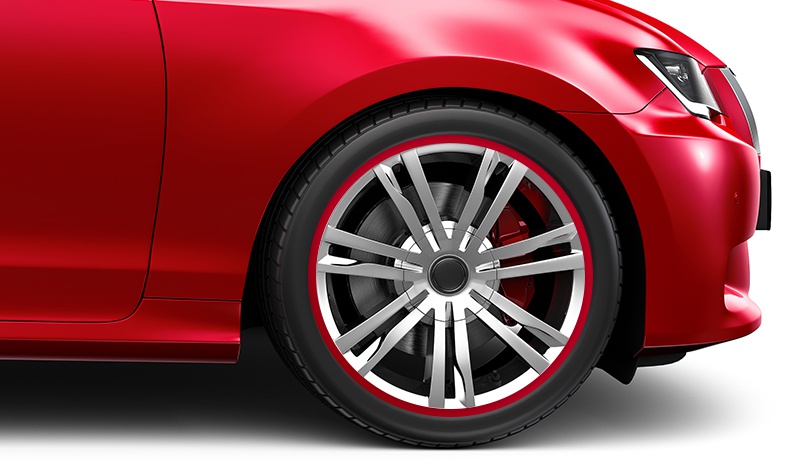Aluminum Alloy vs. Rubber Rim Protectors: Which Truly Protects Your Wheels Better?
Why Rim Protectors Deserve Your Attention
Most drivers pay attention to car paint, tires, and detailing—but wheels are often overlooked. Yet they face daily threats: curbs, stone chips, parking mishaps. A scraped alloy wheel ruins your car's look and can lead to costly repairs.
Rim protectors are more than just accessories—they're preventive tools. And among the many materials out there, two dominate the conversation:
🟢 Rubber – Affordable and flexible
🔴 Aluminum Alloy – Premium and durable
But which one offers better protection in real-world use? Let's break it down.
Part 1: Understanding the Two Materials
What Is a Rim Protector?
A rim protector is a thin strip applied along the outer edge of your wheel, acting as a buffer between the rim and road hazards.
It can:
- Prevent curb rash and scratches
- Add a decorative finish
- Extend the life of your wheels
What Is Aluminum Alloy?
A mix of lightweight metals (usually aluminum, magnesium), anodized for corrosion resistance. Stronger and more rigid than plastic or rubber.
What Is Automotive Rubber?
Flexible, shock-absorbing rubber (often EPDM or silicone-based) designed for outdoor use. It's cheaper, softer, and more forgiving on impact.
Part 2: How Each Performs Under Pressure
Aluminum Alloy Rim Protectors
What Makes Them Stand Out:
- Think of them as hard armor for your wheels—great at handling deep scrapes and curb damage.
- They're built to last, with UV-resistant anodized finishes that don't fade or crack easily.
- Want your car to stand out? These offer a sleek, high-end look with customizable color options.
What to Keep in Mind:
- They're pricier, usually between $50–$100 a set.
- Installation can be tricky—some models require adhesive or trimming and might benefit from a professional touch.
- Being rigid, they don't absorb shocks like rubber, which can be noticeable on rougher terrain.
Best Suited For:
- Performance-focused or luxury cars
- Drivers frequently navigating curbs, potholes, or city traffic
Rubber Rim Protectors
Why Drivers Love Them:
- Their flexibility helps absorb small bumps—perfect for light curb contact.
- Easy to install at home—peel, stick, or snap them into place.
- They're affordable, with most sets priced around $15–$30, making them a great entry-level choice.
- Rubber adds a bit of vibration dampening, which can lead to a smoother, quieter ride.
Possible Trade-Offs:
- They don't last as long—sun and rain can cause them to dry out, crack, or peel over time.
- Style options are limited—mostly black or gray, so it's not ideal for flashy builds.
- They offer only basic protection—if you hit a curb hard, your wheel might still suffer damage.
Great For:
- Daily drivers, family cars, or first-time modders
- People who want a quick, affordable layer of protection without breaking the bank
Part 3: Scientific Comparison Table
| Feature | Aluminum Alloy | Rubber |
|---|---|---|
| Hardness | ★★★★★ (resists deep scrapes) | ★★☆☆☆ (good for minor bumps) |
| Durability | 5+ years (weatherproof) | 2–3 years (age faster outdoors) |
| Custom Colors | Yes (anodized finish) | Limited (mostly black) |
| Shock Absorption | Poor | Good |
| Installation | Moderate to complex | Easy |
| Noise Reduction | No | Yes |
| Average Price | $50–$100 | $15–$30 |
Part 4: How to Choose the Right One
Choose Aluminum Alloy If:
- Your value looks as much as the function
- You live in a high-risk area (bad roads, tight curbs)
- You're investing in long-term protection
- Your wheels are premium alloys worth preserving
Choose Rubber If:
- You're on a budget
- You want something quick and easy
- You drive a lot, but mostly in well-paved areas
- Do you prefer a softer, quieter ride
Bonus Tip: Mix & Match Smartly
Want the best of both worlds?
Use aluminum on the front wheels (most impact risk)
Use rubber on the rear wheels (less contact, cost-saving)
It's an innovative, hybrid approach used by tuners and detailers.
Maintenance Tips (for Both Types)
Aluminum Protectors:
- Clean gently with water and a soft cloth
- Avoid abrasive polishes that strip the finish
- Check adhesive edges every 3–6 months
Rubber Protectors:
- Avoid long sun exposure
- Clean monthly to remove grime
- Replace when cracked or faded
FAQs: What Car Owners Are Asking
Q1: Will aluminum protectors make my wheels heavier?
🅰️ No, they're lightweight and won't affect handling or fuel economy.
Q2: Will rubber protectors crack in cold weather?
🅰️ Cheap ones might. Use cold-resistant automotive rubber if you're in winter zones.
Q3: Can I install them myself?
🅰️ Yes! Rubber is beginner-friendly. Aluminum may take more time, but it is doable with care.
Conclusion: Long-Term vs. Low-Cost—What Matters More to You?
Both materials serve a purpose.
If you aim for serious protection, long-term durability, and aesthetic edge, aluminum alloy rim protectors are worth the upgrade.
Rubber gets the job done if you're more focused on saving money and light impact coverage.
Either way, protecting your wheels is a wise investment that keeps your car looking great and shields it from daily driving damage.



